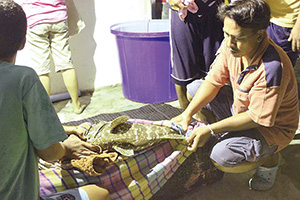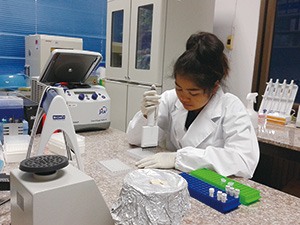(3) Food and Nutrition
According to “The State of Food Insecurity in the World 2014 (SOFI2014),”a report which has been jointly prepared by the Food and Agriculture Organization of the United Nations (FAO), the International Fund for Agricultural Development (IFAD) and the World Food Programme (WFP), positive trends were found – the number of undernourished people in the world was down by more than 100 million over the last decade and by more than 200 million since 1990-92. However, about 805 million people (2012-2014 estimates) are said to remain chronically undernourished.
This report suggests that the goal to halve the proportion of undernourished people by 2015, which is one of the Millennium Development Goals is within reach “if appropriate and immediate efforts are stepped up.” In addition, there is a need for international coordination and multifaceted measures to establish food security (guaranteeing the right of all people to sufficient food), such as establishing a social safety-net (a mechanism in which people can live safely and with peace of mind), improving nutrition, providing necessary food assistance, and implementing measures against infectious diseases of livestock.
Furthermore, initiatives to improve nutrition during the first 1,000 days from a mother's pregnancy to her child's second birthday, which is particularly effective in addressing the issue of malnutrition, are being promoted.
< Japan's Efforts >

A Japan Overseas Cooperation Volunteer, Ms. Mika Aradono, who is involved in community development, organized a cooking demonstration and tasting event with the cooperation of a grocery shop in Naivasha, a provincial city located about 70km from Nairobi, the capital city of Kenya. (Photo: Mika Aradono)
In light of these circumstances, Japan provides food assistance based on requests from developing countries confronting food shortages. In FY2013, Japan contributed a total of ¥5.01 billion through bilateral food assistance projects in 11 countries.
Japan also provides assistance in this area through international organizations, mainly through the WFP. These include emergency food assistance, support for school feeding programs to increase access to education, and food assistance that promotes participation in the development of agricultural land and of social infrastructure by distributing food to support the self-reliance of local communities. In 2013, Japan contributed a total of $238.43 million to WFP projects being implemented around the world.
Meanwhile, Japan provides support for research on the development of varieties conducted by the Consultative Group on International Agricultural Research (CGIAR), which is comprised of 15 agricultural research centers, as well as promoting cooperation through exchanges among researchers.
In addition, Japan also supports the efforts of developing countries to enhance their own food safety. Concerning animal infectious diseases that spread beyond national borders such as foot-and-mouth disease, Japan is reinforcing countermeasures in the Asia-Pacific region, in cooperation with the World Organisation for Animal Health (OIE) and FAO, including the Global Framework for Progressive Control of Transboundary Animal Diseases (GF-TADs). Furthermore, Japan is deeply involved in the Scaling Up Nutrition (SUN) movement, which internationally leads initiatives to improve the condition of malnutrition, and has pledged to strengthen its assistance.
| Thailand
Development of Aquaculture Technology for Food Security and Food Safety in the Next Generation
Science and Technology Research Partnership for Sustainable Development (SATREPS)
(May 2012 – Ongoing)

Taking egg samples from a parent of brown-marbled grouper for artificial fertilization. (Photo: Krabi Coastal Fisheries Research and Development Centre)

Conducting a diagnosis at a coastal fish farming research agency. (Photo: Satoshi Kubota, a researcher dispatched from the Japan Science and Technology Agency (JST))
With fishery production around the world reaching its limit, aquaculture production accounts for over 40% of the global production of marine products. The growth of aquaculture production is supporting the consumption of marine products that continues to increase worldwide. Southeast Asia is one of the leading aquaculture production regions in the world, accounting for approximately 30% of the global aquaculture production volume. Thailand plays a central role in this context.
In order to ensure the sustainable growth of the aquaculture industry in Southeast Asia, it is essential to develop aquaculture technologies for popular fish varieties in the market, including grouper, sea bass, and tiger prawn. However, investment in the development of such technologies has made little progress due to the considerable burden it places on the government and the private sector, coupled with the need for advanced know-how on science and technology.
Against this background, Japan is providing technical cooperation in Thailand, the center of aquaculture production in Southeast Asia, with the aim of developing aquaculture technologies to produce sustainable and high quality fish and seafood products that have high market value. Specifically, this technical cooperation is contributing to the prevention of the infection of fish and seafood, development of new species using molecular genetic information, establishment of “surrogate” aquaculture technology that enables production of a different type of fish from its parent, development of new feed, and ensuring the safety of marine products, among other activities.
As a research outcome, this project has established a diagnostic method that can detect with 100% accuracy the infection of the bacterium that causes mass deaths of shrimps, which have led to huge losses in Southeast Asia. It is expected that the dissemination of this diagnostic technology will make a significant contribution to global shrimp aquaculture by enabling the early detection and responses to infections and recovering the declining global shrimp production volume.
(As of August 2014)
